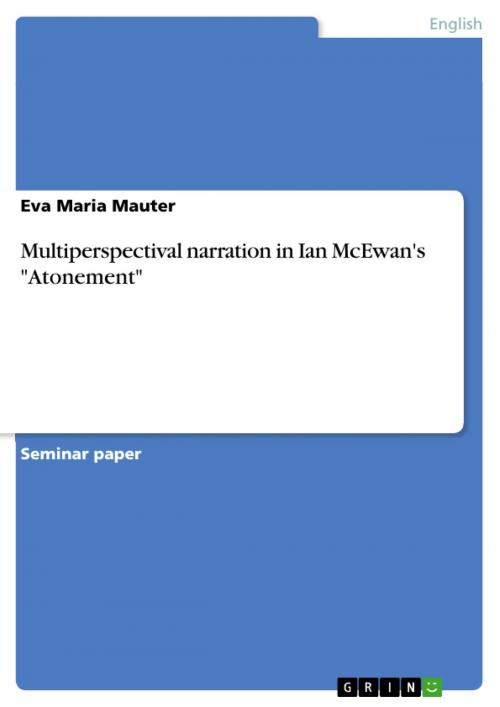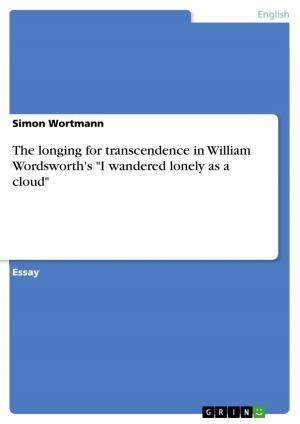Multiperspectival narration in Ian McEwan's 'Atonement'
Fiction & Literature, Literary Theory & Criticism, British| Author: | Eva Maria Mauter | ISBN: | 9783638607025 |
| Publisher: | GRIN Publishing | Publication: | February 8, 2007 |
| Imprint: | GRIN Publishing | Language: | English |
| Author: | Eva Maria Mauter |
| ISBN: | 9783638607025 |
| Publisher: | GRIN Publishing |
| Publication: | February 8, 2007 |
| Imprint: | GRIN Publishing |
| Language: | English |
Seminar paper from the year 2004 in the subject English Language and Literature Studies - Literature, grade: 1,3, University of Paderborn, course: Ian McEwan, 18 entries in the bibliography, language: English, abstract: In this thesis Ansgar Nünning's concept of multiperspectival narration is applied to Ian McEwan's Atonement in great detail. Hence, the thesis is of interest to everybody who is concerned with 'perspective' or 'multiperspectivity' in narrations as well as students of Ian McEwan's work. In post-modern english literature, Ian McEwan has received considerable attention from critics and scholars and his writing is certainly most noteworthy. In his best-selling novel 'Atonement', McEwan employs a multitude of subjective perspectives which is not only a key element for suspense and understanding the plot but also an instrument of reception control. In order to gain access to the narrational strategies of the novel and for a deeper understanding of McEwan's perfect controll of narratological and stylistic devices, Ansgar and Vera Nünning's concept to analyze multiperspectivity in narration is applied to 'Atonement'. Although A. and V. Nünning's concept augments modern narratology with an extraordinary instrument to analyze perspectivity, it lacks application so far. Ian McEwan's 'Atonement' provides an excellent field for exploring multiperspectivity. So this essay will use A. and V. Nünning's categories in order to analyze the structure of perspectives and its controlling functuin in McEwan's 'Atonement'. Therefore, the general concept of A. and V. Nünning concerning multiperspectivity is introduced at first. It is necessary to have a close look at forms of multiperspectivity and the single perspectives first in order to analyze the structure of perspectives which are explored in the paradigmatic and the syntagmatic dimension. Even if the structures of perspectives may function already as a controlling strategy, control of reception will be explained in more detail. Then, this concept is applied to Ian McEwan's narration Atonement. Before the structure of the perspectives is explored in the paradigmatic and the syntagmatic dimension, the forms of multiperspectival narration in Atonement are stated. The various strategies to control the reception are summerized and the first impression of the effect of multiperspectivity in Atonement is briefly described. This in-depht analysis of Ian McEwan's 'Atonement' with A. and V. Nünning's concept of multiperspectivity establishes a fundamental comprehension of McEwan's use of perspectivity in narration and provides the reader with a profound narratological background for the understanding of 'Atonement'.
Seminar paper from the year 2004 in the subject English Language and Literature Studies - Literature, grade: 1,3, University of Paderborn, course: Ian McEwan, 18 entries in the bibliography, language: English, abstract: In this thesis Ansgar Nünning's concept of multiperspectival narration is applied to Ian McEwan's Atonement in great detail. Hence, the thesis is of interest to everybody who is concerned with 'perspective' or 'multiperspectivity' in narrations as well as students of Ian McEwan's work. In post-modern english literature, Ian McEwan has received considerable attention from critics and scholars and his writing is certainly most noteworthy. In his best-selling novel 'Atonement', McEwan employs a multitude of subjective perspectives which is not only a key element for suspense and understanding the plot but also an instrument of reception control. In order to gain access to the narrational strategies of the novel and for a deeper understanding of McEwan's perfect controll of narratological and stylistic devices, Ansgar and Vera Nünning's concept to analyze multiperspectivity in narration is applied to 'Atonement'. Although A. and V. Nünning's concept augments modern narratology with an extraordinary instrument to analyze perspectivity, it lacks application so far. Ian McEwan's 'Atonement' provides an excellent field for exploring multiperspectivity. So this essay will use A. and V. Nünning's categories in order to analyze the structure of perspectives and its controlling functuin in McEwan's 'Atonement'. Therefore, the general concept of A. and V. Nünning concerning multiperspectivity is introduced at first. It is necessary to have a close look at forms of multiperspectivity and the single perspectives first in order to analyze the structure of perspectives which are explored in the paradigmatic and the syntagmatic dimension. Even if the structures of perspectives may function already as a controlling strategy, control of reception will be explained in more detail. Then, this concept is applied to Ian McEwan's narration Atonement. Before the structure of the perspectives is explored in the paradigmatic and the syntagmatic dimension, the forms of multiperspectival narration in Atonement are stated. The various strategies to control the reception are summerized and the first impression of the effect of multiperspectivity in Atonement is briefly described. This in-depht analysis of Ian McEwan's 'Atonement' with A. and V. Nünning's concept of multiperspectivity establishes a fundamental comprehension of McEwan's use of perspectivity in narration and provides the reader with a profound narratological background for the understanding of 'Atonement'.















